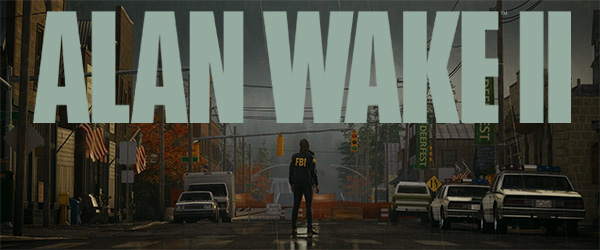
I'll give Remedy this bit of credit: in a world overrun with soul-less, design-by-committee, live-services and vehicles for micro-transaction economies, Alan Wake 2 is a game that actually has a strong creative vision and personality. It follows in the footsteps of Hideo Kojima and Death Stranding by being completely confident in itself and being un-abashedly weird. And just like with Death Stranding, that means that sometimes Alan Wake 2 is genius; other times it's confoundingly stupid and hackneyed!
It's hard even to classify Alan Wake 2 into a single genre. That goes for both narrative genre and also ludic genre. In both cases, it's kind of all over the place. At the most reductionist level, it follows the basic formula of a modern horror game: exploring creepy environments to find keys for doors, fighting monsters as an over-the-shoulder 3rd-person shooter, solving puzzles, and managing a limited inventory. So it's a "horror game", right? In fact, sometimes, it's seriously scary and disturbing. But other times, I'm questioning its "horror" status while I'm laughing out loud to a deliberate joke, or bored out of my mind because nothing scary or particularly exciting has happened in hours. Yet other times still, it's farcically campy or schlocky, and un-intentionally laughable. It's story is ridiculously out there in its concepts and execution, but somehow every beat of the plot is set up and signposted as clearly and obviously as the neon signs that point the player to the next objective in the Dark Place.
Plot twists are signposted more clearly and obviously than the neon signs that often guide the player through levels.
It's also frequently up its own ass. It is, after all, a fictional story about the power of fiction to alter reality (and our perception of reality). It even features the lead designer as a self-insert character within the story. Though surprisingly, he made himself a secondary character instead of one of the 2 playable protagonists. So it's not really about him, but he still found a way to make the entire plot revolve around that secondary character.
In the mind's eye
I feel that Alan Wake 2 is consistently at its best when its sitting firmly in its horror-mystery mode. As such, the opening couple hours of the game really pulled me in and hooked me. The game's main quest and side content are split up into various "cases" for the FBI agent protagonists to solve. There's a mechanic in which the player can retreat into Agent Saga Anderson's "Mind Space", which is an imaginary office room in which she sorts through all the clues she's gathered and strings them together on an imaginary wall in order to fit the puzzle pieces of the mystery together. Each time the player discovers a critical piece of information in the game world, it will show up in the Mind Space's filing cabinet as a new file in a case folder. Putting the clues together in the right way will unlock new lines of inquiry, and can even reveal the next objective.
Agent Anderson can review the known evidence in her imaginary Mind Space office.
Apparently, the actual game doesn't even pause, and continues to play in the background while the player is in the Mind Space. Even though the Mind Space is a full-screen environment, the character can still be attacked by enemies in the "real world". At first, I thought this would be obnoxious, but after the first time I was attacked while trying to re-arrange items on the case board in the Mind Space, I learned my lesson. After that, I actually came to realize that that needing to find a safe, peaceful space in order to let the character think about clues they've discovered (and how to proceed), really helps to emphasize the danger and stakes of the situation.
Arranging the clues in the Mind Space is not very difficult or complicated. It's not like having to solve a person's fate in Return of the Obra Dinn, or anything like that. Most of the time, the process is just going through the motions. Even when there are multiple options for where a piece of evidence can go, the solution can be easily brute-forced without the player having to know anything about what's going on.
The Case Board is an immersive quest log and objective tracker.
Even so, the Mind Space is a creative idea for presenting objectives, quest logs, story summaries, and characterization. The Mind Space at least tries to force the player to have to engage with the events of the story in a meaningful and immersive way. The player has to at least pretend to know how the various events of the story, the characters, and the McGuffins you find all fit together in the broader story in order to progress the main story or side quests.
And in fact, the entire game is about the interplay between the audience and the fiction. For most of the story, it's about the ability of fiction to re-shape people's perception of reality, but as the game goes on, it becomes more and more about the audience's ability to shape or re-shape the actual fiction. It emphasizes that any creative work is made up of both the voices of its creator(s) and also the interpretation and reception of the audience. This has always been true, with all forms of fiction and story-telling, but it's even more true with video games.
[More]
70bf8397-0bac-4efb-82b9-fb0c24ee8da7|0|.0
Tags:Alan Wake, Alan Wake 2, Remedy, PS5, horror, fiction, shooter, mystery, investigation, light, dark, shadow, flashlight, forest, paranormal, music, cult, Federal Bureau of Investigation, Federal Bureau of Control
At the top of my list of favorite game franchises, sits 2 seemingly unlikely companions: one is the first 4 Silent Hill games developed by Konami's internal "Team Silent" studio; the other is the series of "Souls-Borne" games created by From Software. If these 2 franchises are not my number 1 and number 2, respectively, then they are both definitely in my top 3, with Sid Meier's Civilization being the only other real contender.
On the surface, Silent Hill and the Souls-Borne games don't seem to have a lot in common, nor would one necessarily think that they would appeal to overlapping audiences. In some senses, it would seem that they couldn't be further apart. Silent Hill is a series of slow-paced psychological horror games with linear narratives, that emphasize puzzles and encourage the player to run away from threats and avoid the games' poorly-developed combat mechanics. The Souls-Borne games are frenetic action-RPGs that barely have any plot at all, and which are built entirely around combat mechanics, and which are infamous for their difficult gameplay. But despite the radically divergent styles of gameplay that these 2 franchise offer, they both contain similar themes and are open to similar artistic interpretations, which appeal to me, personally because of a particular aspect of my core beliefs and identity.
You see, I'm an atheist. More specifically, I consider myself to be a "strong atheist", "anti-theist", and "secular humanist", among other labels. Not only do I not accept any of the various god-claims due to insufficient evidence; I also positively believe and assert, with confidence, that there are no gods at all. Now, I'm sure that I've just invited a slew of commenters who will try to convert me or share their beliefs for why their personal god is real, but I'm not here to argue about the theology. Besides, I've pretty much heard it all. Not just on the internet, but also from extended family. God of the gaps, personal incredulity, watch-maker, Pascal's Wager, Kalam and other various Cosmological Arguments. I've heard it all -- or at least most of it. And I reject it all.
I am as confident in my belief that there is no god, as I am in my belief that there is no Santa Clause (and for many of the same reasons). So unless you think you can convince me that Santa Clause is real, you're probably wasting your time trying to convince me about your god.
View this entire essay in video format on YouTube.
But my atheism goes a bit further. I'm also an anti-theist, and I believe that religion and religious institutions are also dangerous and do more harm to society than good.
And based on my own personal reading of both Silent Hill and the Souls-Bornes, it seems that both game franchises kind of agree with me. [More]
e41c0e7e-50b9-4d3d-ad3d-eedbb712815d|10|2.1
Tags:atheism, religion, god, faith, Silent Hill, From Software, Demon's Souls, Dark Souls, Bloodborne, Elden Ring, Star Trek, original sin, Christianity, Judaism, curse, Way of White, Healing Church, blood ministration, orphanage, cult, abortion

Last year, YouTuber Super Eyepatch Wolf posted a video titled "The Problem with Silent Hill 3: the Downfall of Team Silent". In that video, Super Eyepatch Wolf asserts that the design of Silent Hill 3 changed early in development, as a result of pressure from Konami. He claims that early designs for the game were going to be a more personal, introspective tale, in the vein of Silent Hill 2.
YouTuber Super Eyepatch Wolf posted a video last year asserting that Silent Hill 3
was originally going to be more similar to Silent Hill 2's personal and introspective story and style.
Konami may not have been happy with this early design because -- believe it or not -- there were apparently many vocal fans of the first Silent Hill game who were upset that Silent Hill 2 had not continued the story set forth by the first game. So Konami mandated that Team Silent make Silent Hill 3 be more of a continuation of the first Silent Hill, and so SH3 was re-written as a direct sequel to the first game, and returned to the narrative of a cult trying to birth a demon god.
I've adapted this blog post into a YouTube video response to Super Eyepatch Wolf.
It's hard to believe, but when it was first released, Silent Hill 2 was not universally regarded as the "gold standard" of video game horror. You can look at middling contemporary reviews from publications like Gamespot and GameInformer. In those days, the series was perceived as being "about occultism", and Silent Hill 2 was a stark deviation. Now, with a generation of gamers having grown up playing and loving Silent Hill 2, there's an effort now to re-frame the entire series as having always been about a haunted town torturing the guilty, even though three out of four of the original games are explicitly about a cult trying to re-birth its demon god, and repressed personal guilt is only featured in one of those four games.
Silent Hill 2 was the only of the original 4 games to be about the protagonist being punished for repressed guilt.
But that may not have always been the plan...
If Super Eyepatch Wolf is correct, then Team Silent may have wanted to pivot the narrative focus of the series away from occultism and towards more personal stories like SH2 -- though, importantly, not necessarily about repressed guilt or amnesia!
I have a complicated relationship with the question of "what is Silent Hill about?" Readers of my personal blog will know that I've rigorously defended the idea of Silent Hill (as a series) being about occultism, and that new entries in the series should respect that history, rather than trying to re-frame the entire series (and the nature of the town itself) to be about a haunted town that summons people to face their hidden guilt.
That being said, it isn't that I have a particular attachment to occult stories, even though a lot of the games that I like (such as Demon's Souls and Blooborne) also have strong occult threads. I also am definitely not opposed to more thoughtful, introspective stories. Silent Hill 2 is my favorite game in the series because of that thoughtful, introspective story! Rather, I've found all the third-party-developed games after Silent Hill 4 to be highly derivative of Silent Hill 2 and not particularly good.
Silent Hill 3 pivoted hard back towards the occult inspirations of the first game.
But is that really what Team Silent wanted?
Super Eyepatch Wolf does have some quotes and evidence to support the idea that Silent Hill 3 was originally intended to be a very different game -- all of which was taken from a single interview. But there's not much (if any) information about what the actual story of that game may have been. Nobody on Team Silent has (as far as I know) talked about it, nor do we have a leaked design document like what we have for Silent Hill: Cold Heart (the Wii-exclusive that eventually transformed into Shattered Memories).
... [More]
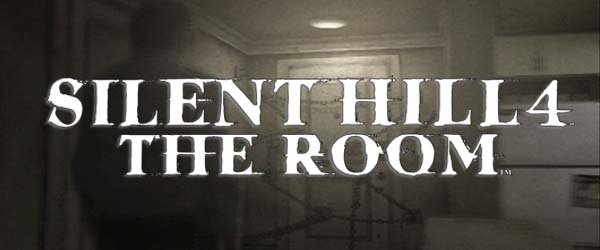
While I was playing through recent horror titles like The Evil Within, I noticed some interesting similarities with Silent Hill 4 that started to give me a new appreciation for some of this game's stronger aspects. In addition, while doing research for my Silent Hill timeline, I had to go back and play through Silent Hill 4: the Room again. I had only played through the game twice before, so I had to replay it in order to figure out how the timeline would work out. And while I was playing the game, I figured that I might as well go ahead and review it. At the time, it seemed like a novel idea to do a retro review of a Silent Hill game that wasn't Silent Hill 2, but lately, I've been seeing a lot of retro-reviews of The Room popping up other places. I haven't done any retro reviews yet; probably the closest thing has been my review of Demon's Souls. But in light of how unsuccessful the later Silent Hill games have been, the unfortunate cancellation of Silent Hills, and the uncertain future of the franchise (and of Konami as a studio), it's a good time to go back to look at what worked and what didn't about the previous games, and explore the question of whether we even want the franchise to continue.
The Room has the reputation of being the "bad" black sheep of the original Silent Hill tetralogy. I always thought that this reputation was unfortunate, and that the game wasn't quite as bad as people made it seem. I actually liked it better than Silent Hill 3 when I first played it, because I had never played the first Silent Hill. After I was able to track down a copy of the first game and play through it, Silent Hill 3 suddenly made a whole lot more sense, and I came to love it almost as much as I loved Silent Hill 2. So while I tend to agree that The Room is the "weakest" of the original Silent Hill games, I never really thought of it as being "bad"; just "less good". The release of future games by third party developers has only made The Room look better in retrospect.
An experimental formula
The game itself is a bit rough around the edges. It deviates significantly from the controls and mechanics established by the previous games in the franchise, and these changes are very hit-or-miss. This might be due, in part, to the possibility that The Room started out as an independent side project that was developed concurrently with Silent Hill 3, and that was eventually redesigned to work as a Silent Hill game in order to be more commercially viable. Whether or not that's true is still a hot issue of debate among the fanbase, but it's obvious to everybody that The Room plays a lot differently from previous titles.
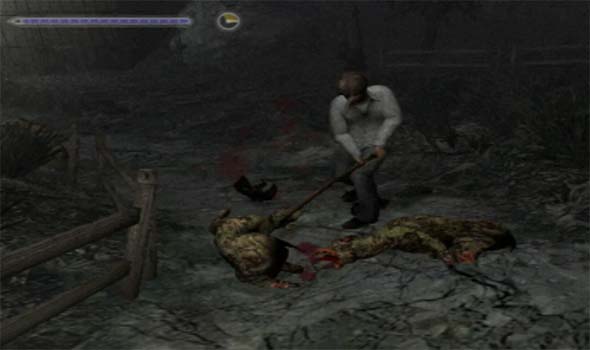
Movement and combat controls are radically changed from previous games in the series.
The most immediately obvious deviation is in movement and camera controls. The semi-first-person "tank" controls have been completely abandoned in favor of direct directional inputs, and the camera is significantly more limited than it has been in previous games. You can't snap the camera behind the character by holding the "look" button as you could do in previous games. Almost all camera angles are pre-set angles, and the player can usually only toggle between two possible camera angles in any given area.
This results in some very clumsy navigation of the environment, and it's very easy for the character to get turned around when camera angles flip. Most of the time, a camera change will go without a hitch, but there are a few frames in the game that consistently result in erratic and unpredictable movement. It happens most often when a camera change occurs concurrently with a change in direction of the character (to navigate around a corner or an obstacle). If the player's timing for changing the character's movement direction is not perfectly-timed, then the character ends up turning around, which can result in getting stuck in a loop between the two camera angles. This is the very reason that I prefer the tank controls. They may be a bit cumbersome, but at least they're consistent and always relative to a single frame of reference (the character's position in the world), rather than to an unpredictable camera.
The second major change is to combat. The game was designed to have a greater emphasis on melee combat, complete with new target-locking controls, a variety of breakable melee weapons, very limited ammunition for guns, and an on-screen meter for charging power attacks. The new movement controls do make it a bit easier to maneuver around enemies (especially multiple enemies), but only if you're in an open space and the camera angle doesn't go all wonky on you. The mechanics are serviceable, and I don't think they're as bad as some critics insist.
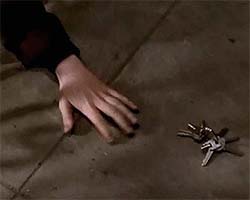
The designers were probably trying to mimic
the horror trope of fumbling for keys.
Inventory management is where things really start to get bad. Henry isn't a walking closet like the previous games' protagonists, and he has only a limited number of inventory slots. This is probably partly the result of the inventory being accessed in real-time by the directional buttons (which also might have played a role in the changes to the movement control scheme being entirely based up on the analog stick), in a desire to create a sense of frantically searching your pockets for a weapon or item while under pressure. It also adds more relevance to the Room 302 hub (another dramatic departure from previous games) by forcing you to go back to restock on supplies or swap out puzzle items.
But it's hindered by a lot of little mistakes... [More]
a5ccd49d-8af1-4839-8eb0-2796d3829980|6|4.5
Tags:Silent Hill, Silent Hill 4: the Room, Konami, Team Silent, KCET, Henry Townshend, Walter Sullivan, Eileen Galvin, room 302, horror, serial killer, murder, cult, occult, 21 Sacrements, sacrifice, ritual, ghost, escort quest, Alfred Hitchcock, retro review

In my previous blog entry about the history of Silent Hill's cult, I had originally intended to include a small section about the cult's name, as it is accepted by series fans: "The Order". However, it wasn't really relevant to the specific topic of the in-game cult history, since it is a more meta point about the games in general. So instead, I decided to make it a brief independent article:
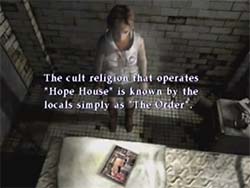
Joseph's article is the source of
the name "The Order".
I am one of a subset of Silent Hill fans who does not like using the term "The Order" to refer to the game's cult. For one thing, the name reminds me of the movie and Homecoming, which causes a resentful knee-jerk reaction. But there are also other in-game evidences to suggest that naming the cult might not have been intentional.
The primary source for the name "The Order" comes from an article written by the journalist Joseph Schreiber which details an orphanage that is run by a sect of Silent Hill's cult.
This article is present in Silent Hill 3 as well as Silent Hill 4: The Room, but there are slight differences in the text of the document in each game. Most noticeably, the name of the orphanage changes between the games. In Silent Hill 3 the article appears in a patient room in Brookhaven, and the orphanage name is given as "Hope House". In The Room, however, that same article gives the orphanage the name "Wish House". It was apparently changed sometime in the development of The Room, or it was mistranslated to begin with.
Silent Hill 4 also doesn't give us any indication as to whether the appearance of this article is intended to retcon the article in Silent Hill 3, or if it players are to assume that the actual text of the article changed at some point after the magazine's publication. Perhaps the article was reprinted in a different magazine and the editor or author changed the name. We don't know if it's the same magazine because in Silent Hill 3 the magazine is closed and we only see its cover and never the page of the article, but in Silent Hill 4 the magazine is sitting open on a desk and we see only the page of the article and not the cover.
"The Order" comes from an article that appears in both Silent Hill 3 (LEFT) and Silent Hill 4 (RIGHT).
But if the name of the orphanage changes between versions, can we trust the name of the cult to be correct?
As far as I can remember, "The Order" is never referred to anywhere else in The Room... [More]
9fac77d9-95be-4c33-a431-c4ba4970c07d|6|4.3
Tags:The Order, Silent Hill, Silent Hill 3, Silent Hill 4: the Room, Silent Hill Homecoming, movie, cult, occult, religion, church, Joseph Schreiber
|

| 12 | | | | | | | 60 | | 11 | | | | | | | 55 | | 10 | | | | | | | 50 | | 09 | | | | | | | 45 | | 08 | | | | | | | 40 | | 07 | | | | | | | 35 | | 06 | | | | | | | 30 | | 05 | | | | | | | 25 | | 04 | | | | | | | 20 | | 03 | | | | | | | 15 | | 02 | | | | | | | 10 | | 01 | | | | | | | 05 |
|